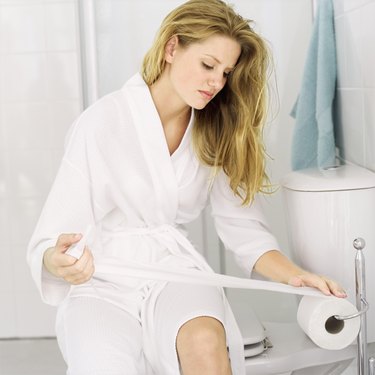
If and when you encounter your toilet overflowing, you can never just ignore it. Simply mopping up the overflowed water won't erase the reason the toilet overflowed in the first place. You need to determine the cause, as a constantly overflowing toilet is a real pain.
Warning
Video of the Day
Never flush the toilet when the water inside the bowl has risen to the edge and is threatening to overflow. Wait until the water level drops back to normal. If the water level does not drop back down, you then need to determine what is causing the blockage. Your first priority is to turn off the water supply to the toilet and prevent further overflowing. The valve to turn off the water supply is normally found to the rear left of the toilet.
Video of the Day
Accidental Foreign Objects
Children are often the main culprits at tossing items that were never designed to go into a toilet drain, such as toys, diapers, clothes or anything else they get their tiny hands on. But accidents do happen to us all, and adults can also easily drop a brush or a cell phone into an open toilet. The bathroom itself is a place filled with objects that can quickly clog a toilet drain, such as bars of soap and wash cloths.
Too Much Trash
It is extremely easy to clog a toilet by adding too much tissue to the drain before a flush, thereby blocking the flow with waste. It is also just as simple to create a blockage by disposing of items in toilets that won't go down easily, even if you assume they will. Items such as wads of paper, balls of tissue, feminine pads or even tampons can quickly clog your toilet if they are tossed down the drain instead of into the waste basket.
Faulty Plumbing
Plumbing systems rely on pressure and then gravity to remove the flushed water and waste. An improperly installed plumbing drain may not sit at a great enough incline to allow the water and waste to move by gravity, and they will therefore simply sit in the pipe. When you flush the toilet more, adding more water into the bowl, the water will build up and overflow. Also, underground plumbing pipes could be blocked by tree roots that have pushed up or grown into a pipe.
Prevention
To help minimize overflowing toilet bowls in the future, keep the toilet seat lid closed when the toilet is not in use. The covered bowl will help protect foreign items from being inadvertently dropped into the toilet drain. Also, if your toilet clogs and overflow are frequently caused by waste, be sure to flush the toilet two or three times after each use to produce more water, which helps flush the waste down the pipes. A plumbing inspection will help determine causes and prevention of blockage caused by problems in the plumbing itself.